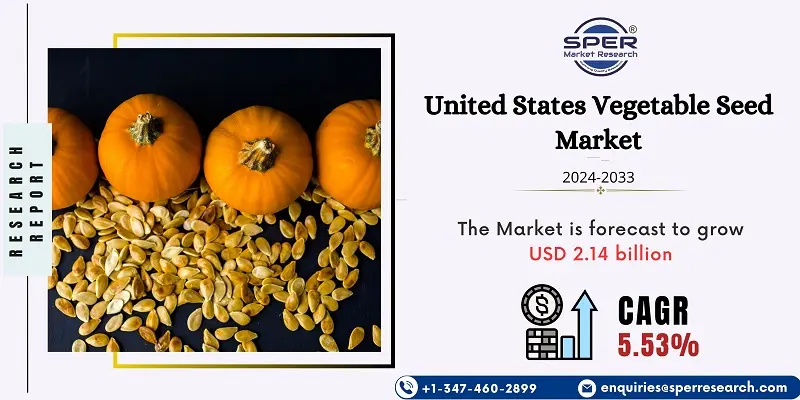
United States Vegetable Seed Market Trends, Share, Size, Demand, Revenue and Future Outlook
United States Vegetable Seed Market Growth, Size, Trends Analysis- By Breeding Technology, By Cultivation Mechanism, By Crop Family- Regional Outlook, Competitive Strategies and Segment Forecast to 2033
| Published: Oct-2024 | Report ID: FOOD24109 | Pages: 1 - 101 | Formats*: |
| Category : Food & Beverages | |||
- July 2023; Fuyu Chiaki is a brand-new winter carrot cultivar from Takii Seeds. These carrots have high cold tolerance and have adapted well to winter circumstances. They also grow well in a variety of soil types, which gives growers more options.
- July 2023; Novel lettuce varieties that show excellent resistance to Bl: 38EU, Bl: 39EU, and Bl: 40EU, three novel Bermian races, were presented by Enza Zaden. The new lettuce varieties are very resistant to these races and can grow on many types of soil and yet produce large amounts of product.


| Report Metric | Details |
| Market size available for years | 2020-2033 |
| Base year considered | 2023 |
| Forecast period | 2024-2033 |
| Segments covered | By Breeding Technology, By Cultivation Mechanism, By Crop Family |
| Regions covered | Northeast, Midwest, South, West |
| Companies Covered | BASF SE, Bayer AG, Bejo Zaden BV, Enza Zaden, Groupe Limagrain, Nong Woo Bio, Rijk Zwaan Zaadteelt en Zaadhandel B.V, Sakata Seeds Corporation, Syngenta Group, Takii and Co. Ltd. |
- Vegetable seed producers and suppliers
- Agricultural companies and cooperatives
- Commercial farmers and growers
- Government agricultural agencies
- Research and development institutions
- Horticultural consultants and advisors
- Agricultural equipment manufacturers
- Distributors and wholesalers of seeds
| By Breeding Technology: | |
| By Cultivation Mechanism: | |
| By Crop Family: |
- United States Vegetable Seed Market Size (FY’2024-FY’2033)
- Overview of United States Vegetable Seed Market
- Segmentation of United States Vegetable Seed Market By Breeding Technology (Hybrids, Open Pollinated Varieties & Hybrid Derivatives)
- Segmentation of United States Vegetable Seed Market By Cultivation Mechanism (Open Field, Protected Cultivation)
- Segmentation of United States Vegetable Seed Market By Crop Family (Brassicas, Cucurbits, Roots & Bulbs, Solanaceae, Unclassified Vegetables)
- Statistical Snap of United States Vegetable Seed Market
- Expansion Analysis of United States Vegetable Seed Market
- Problems and Obstacles in United States Vegetable Seed Market
- Competitive Landscape in the United States Vegetable Seed Market
- Impact of COVID-19 and Demonetization on United States Vegetable Seed Market
- Details on Current Investment in United States Vegetable Seed Market
- Competitive Analysis of United States Vegetable Seed Market
- Prominent Players in the United States Vegetable Seed Market
- SWOT Analysis of United States Vegetable Seed Market
- United States Vegetable Seed Market Future Outlook and Projections (FY’2024-FY’2033)
- Recommendations from Analyst
1.1. Scope of the report1.2. Market segment analysis
2.1. Research data source
2.1.1. Secondary Data2.1.2. Primary Data2.1.3. SPER’s internal database2.1.4. Premium insight from KOL’s
2.2. Market size estimation
2.2.1. Top-down and Bottom-up approach
2.3. Data triangulation
4.1. Driver, Restraint, Opportunity and Challenges analysis
4.1.1. Drivers4.1.2. Restraints4.1.3. Opportunities4.1.4. Challenges
4.2. COVID-19 Impacts of the United States Vegetable Seed Market
5.1. SWOT Analysis
5.1.1. Strengths5.1.2. Weaknesses5.1.3. Opportunities5.1.4. Threats
5.2. PESTEL Analysis
5.2.1. Political Landscape5.2.2. Economic Landscape5.2.3. Social Landscape5.2.4. Technological Landscape5.2.5. Environmental Landscape5.2.6. Legal Landscape
5.3. PORTER’s Five Forces
5.3.1. Bargaining power of suppliers5.3.2. Bargaining power of buyers5.3.3. Threat of Substitute5.3.4. Threat of new entrant5.3.5. Competitive rivalry
5.4. Heat Map Analysis
6.1. United States Vegetable Seed Market Manufacturing Base Distribution, Sales Area, Product Type6.2. Mergers & Acquisitions, Partnerships, Product Launch, and Collaboration in United States Vegetable Seed Market
7.1. United States Vegetable Seed Market Size, Share and Forecast, By Breeding Technology, 2020-20267.2. United States Vegetable Seed Market Size, Share and Forecast, By Breeding Technology, 2027-20337.3. Hybrids7.4. Open Pollinated Varieties7.5. Hybrid Derivatives
8.1. United States Vegetable Seed Market Size, Share and Forecast, By Cultivation Mechanism, 2020-20268.2. United States Vegetable Seed Market Size, Share and Forecast, By Cultivation Mechanism, 2027-20338.3. Open Field8.4. Protected Cultivation
9.1. United States Vegetable Seed Market Size, Share and Forecast, By Crop Family, 2020-20269.2. United States Vegetable Seed Market Size, Share and Forecast, By Crop Family, 2027-20339.3. Brassicas9.4. Cucurbits9.5. Roots & Bulbs9.6. Solanaceae9.7. Unclassified Vegetables
10.1. United States Vegetable Seed Market Size and Market Share By Region (2020-2026)10.2. United States Vegetable Seed Market Size and Market Share By Region (2027-2033)10.3. Northeast10.4. Midwest10.5. South10.6. West
11.1. BASF SE
11.1.1. Company details11.1.2. Financial outlook11.1.3. Product summary11.1.4. Recent developments
11.2. Bayer AG
11.2.1. Company details11.2.2. Financial outlook11.2.3. Product summary11.2.4. Recent developments
11.3. Bejo Zaden BV
11.3.1. Company details11.3.2. Financial outlook11.3.3. Product summary11.3.4. Recent developments
11.4. Enza Zaden
11.4.1. Company details11.4.2. Financial outlook11.4.3. Product summary11.4.4. Recent developments
11.5. Groupe Limagrain
11.5.1. Company details11.5.2. Financial outlook11.5.3. Product summary11.5.4. Recent developments
11.6. Nong Woo Bio
11.6.1. Company details11.6.2. Financial outlook11.6.3. Product summary11.6.4. Recent developments
11.7. Rijk Zwaan Zaadteelt en Zaadhandel B.V
11.7.1. Company details11.7.2. Financial outlook11.7.3. Product summary11.7.4. Recent developments
11.8. Sakata Seeds Corporation
11.8.1. Company details11.8.2. Financial outlook11.8.3. Product summary11.8.4. Recent developments
11.9. Syngenta Group
11.9.1. Company details11.9.2. Financial outlook11.9.3. Product summary11.9.4. Recent developments
11.10. Takii and Co. Ltd.
11.10.1. Company details11.10.2. Financial outlook11.10.3. Product summary11.10.4. Recent developments
11.10.5. Others
SPER Market Research’s methodology uses great emphasis on primary research to ensure that the market intelligence insights are up to date, reliable and accurate. Primary interviews are done with players involved in each phase of a supply chain to analyze the market forecasting. The secondary research method is used to help you fully understand how the future markets and the spending patterns look likes.
The report is based on in-depth qualitative and quantitative analysis of the Product Market. The quantitative analysis involves the application of various projection and sampling techniques. The qualitative analysis involves primary interviews, surveys, and vendor briefings. The data gathered as a result of these processes are validated through experts opinion. Our research methodology entails an ideal mixture of primary and secondary initiatives.



Frequently Asked Questions About This Report
PLACE AN ORDER
Year End Discount
Sample Report
Pre-Purchase Inquiry
NEED CUSTOMIZATION?
Request CustomizationCALL OR EMAIL US
100% Secure Payment






Related Reports
Our Global Clients
Our data-driven insights have influenced the strategy of 200+ reputed companies across the globe.






















